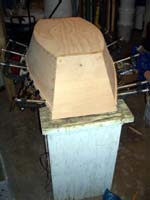For the recent birth of my firstborn son, Christopher, I had intended to build a boat cradle. I bought The Expectant Father's Cradle Boat Book, but neither of the designs was exactly what I wanted tbuild. I played around with Greg Carlson's Hulls software and built a couple of cardboard models. As with all my projects, there were delays (and procrastination), and on October 11, when Christopher was born, I still hadn't settled on a final plan, much less bought wood or begun building.
That's when I turned to Jordan Wood Boats for the Papoose kit. The kit icluded plans, instructions, fasteners, and all the parts pre-cut, beveled, and rough sanded. The transoms and rockers are alder, the bottom is radiata pine, and the sides are oak/luan plywood. All I have to provide are glue, finish, tools, and time. I used a screwdriver, hammer, jigsaw, flush-cut pull saw, chisel, block plane, and spokeshave.
|
As far as time, the cradle went together quickly. It took an hour and a half to unpack the box and review the plans and instructions, and then to assemble the sides, transoms, and bottom.
(click images to enlarge) |
|
|
Installing the gunwales took another 30 minutes. |
 |
|
|
Cutting and beveling the curves on the transom, and installing the the inwales and knees took another two and a half hours.
|
|
|
Attaching the rockers took about 30 minutes.
|
 |
|
To finish, I used 100% pure Tung oil from Lee Valley tools for a non-toxic finish, followed by a coat of orange wax polish for a bit more shine. The pure tung oil is much thicker than the usual "tung oil finish" available at the big box home inprovement stores, and takes a good bit longer to dry. The final coat took about 4 days to dry. On the other hand, it smells much better and has no VOCs.
The plans called for extra-firm 3/4-inch foam, which I was unable to find locally. (The fabric stores here didn't have foam less than an inch, and it was all too soft.) Instead, I used a closed-cell foam camping matress that came in at 1/2-inch thick and is plenty firm. I got some soft cotton twill for a cover, and basically made a pillow case to fit the curved pad. I made a pattern out of butcher paper and cut the fabric, but I relied on my first cousin once removed who was kind enough to sew the covers for me.

